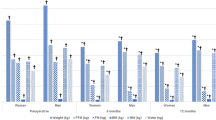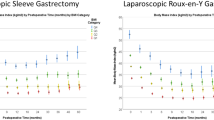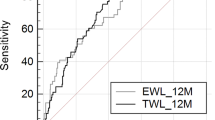Abstract
Background/Objectives:
Body weight, body mass index (BMI) and excess weight loss (EWL) are the most frequently used measures to analyse bariatric surgery outcomes. However, these measurements do not provide accurate information on body composition (BC) with body fat (BF), importantly determining the levels of cardiometabolic risk factors. Our aim was to analyse the evolution of BC after Roux-en-Y Gastric Bypass (RYGB) and its influence on the changes of cardiometabolic risk factors in comparison to BMI and EWL.
Subjects/Methods:
A group of 81 obese Caucasian patients (19 males/62 females) aged 44.9±1.3 years undergoing RYGB between January 2006 and December 2011 was prospectively followed up for a period of 3 years. BC was determined by air-displacement plethysmography. Visceral adiposity, physical activity and cardiometabolic risk factors were measured.
Results:
BF was markedly (P<0.001) reduced after the first year, increasing progressively during the second and third years after RYGB, following a different trajectory than body weight, BMI and EWL that decreased up to the second year post surgery. Markers of glucose homeostasis decreased during the first month and continued to decrease during the first year (P<0.05), remaining stabilised or slightly increased between the second and third years following RYGB. However, markers of lipid metabolism decreased (P<0.05) markedly during the first 12 months, increasing thereafter in parallel to the changes observed in BC, with the exception of high-density lipoprotein-cholesterol, which increased progressively throughout the whole period analysed.
Conclusions:
The adverse switch in the changes in BC between the first and the second years after RYGB may underlie the changes observed in cardiometabolic risk factors. Tracking of adiposity during the follow-up of bariatric/metabolic surgery yields clinically relevant information to better identify patients in need of increased lifestyle advice or treatment intensification.
This is a preview of subscription content, access via your institution
Access options
Subscribe to this journal
Receive 12 print issues and online access
$259.00 per year
only $21.58 per issue
Buy this article
- Purchase on Springer Link
- Instant access to full article PDF
Prices may be subject to local taxes which are calculated during checkout





Similar content being viewed by others
References
Frühbeck G, Toplak H, Woodward E, Yumuk V, Maislos M, Oppert JM . Obesity: the gateway to ill health - an EASO position statement on a rising public health, clinical and scientific challenge in Europe. Obes Facts 2013; 6: 117–120.
Bray GA, Frühbeck G, Ryan DH, Wilding JP . Management of obesity. Lancet 2016; 387: 1947–1956.
Sjöström L, Narbro K, Sjöström CD, Karason K, Larsson B, Wedel H et al. Effects of bariatric surgery on mortality in Swedish obese subjects. N Engl J Med 2007; 357: 741–752.
Frühbeck G . Bariatric and metabolic surgery: a shift in eligibility and success criteria. Nat Rev Endocrinol 2015; 11: 465–477.
Mehaffey JH, LaPar DJ, Clement KC, Turrentine FE, Miller MS, Hallowell PT et al. 10-year outcomes after roux-en-Y gastric bypass. Ann Surg 2016; 264: 121–126.
Courcoulas AP, Goodpaster BH, Eagleton JK, Belle SH, Kalarchian MA, Lang W et al. Surgical vs medical treatments for type 2 diabetes mellitus: a randomized clinical trial. JAMA Surg 2014; 149: 707–715.
Mingrone G, Panunzi S, De Gaetano A, Guidone C, Iaconelli A, Nanni G et al. Bariatric–metabolic surgery versus conventional medical treatment in obese patients with type 2 diabetes: 5 year follow-up of an open-label, single-centre, randomised controlled trial. Lancet 2015; 386: 964–973.
Ikramuddin S, Billington CJ, Lee WJ, Bantle JP, Thomas AJ, Connett JE et al. Roux-en-Y gastric bypass for diabetes (the Diabetes Surgery Study): 2-year outcomes of a 5-year, randomised, controlled trial. Lancet Diabetes Endocrinol 2015; 3: 413–422.
Sjöström L, Peltonen M, Jacobson P, Sjöström CD, Karason K, Wedel H et al. Bariatric surgery and long-term cardiovascular events. JAMA 2012; 307: 56–65.
Sjöström L . Review of the key results from the Swedish Obese Subjects (SOS) trial - a prospective controlled intervention study of bariatric surgery. J Intern Med 2013; 273: 219–234.
Lupoli R, Di Minno MN, Guidone C, Cefalo C, Capaldo B, Riccardi G et al. Effects of bariatric surgery on markers of subclinical atherosclerosis and endothelial function: a meta-analysis of literature studies. Int J Obes 2016; 40: 395–402.
Fried M, Yumuk V, Oppert JM, Scopinaro N, Torres AJ, Weiner R et al. Interdisciplinary European guidelines on metabolic and bariatric surgery. Obes Facts 2013; 6: 449–468.
American Society for Bariatric Surgery Standards Committee 2004-2005 American Society for Bariatric Surgery Standards Committee 2004-2005 Oria HE, American Society for Bariatric Surgery Standards Committee 2004-2005 Carrasquilla C, American Society for Bariatric Surgery Standards Committee 2004-2005 Cunningham P, American Society for Bariatric Surgery Standards Committee 2004-2005 Hess DS, American Society for Bariatric Surgery Standards Committee 2004-2005 Johnell P et al. Guidelines for weight calculations and follow-up in bariatric surgery. Surg Obes Relat Dis 2005; 1: 67–68.
Golomb I, Ben David M, Glass A, Kolitz T, Keidar A . Long-term metabolic effects of laparoscopic sleeve gastrectomy. JAMA Surg 2015; 150: 1051–1057.
Gómez-Ambrosi J, Silva C, Galofré JC, Escalada J, Santos S, Millán D et al. Body mass index classification misses subjects with increased cardiometabolic risk factors related to elevated adiposity. Int J Obes 2012; 36: 286–294.
Gómez-Ambrosi J, Silva C, Catalán V, Rodríguez A, Galofré JC, Escalada J et al. Clinical usefulness of a new equation for estimating body fat. Diabetes Care 2012; 35: 383–388.
Cummings DE, Cohen RV . Beyond BMI: the need for new guidelines governing the use of bariatric and metabolic surgery. Lancet Diabetes Endocrinol 2014; 2: 175–181.
Gómez-Ambrosi J, Moncada R, Valentí V, Silva C, Ramírez B, Catalán V et al. Cardiometabolic profile related to body adiposity identifies patients eligible for bariatric surgery more accurately than BMI. Obes Surg 2015; 25: 1594–1603.
Das SK, Roberts SB, McCrory MA, Hsu LK, Shikora SA, Kehayias JJ et al. Long-term changes in energy expenditure and body composition after massive weight loss induced by gastric bypass surgery. Am J Clin Nutr 2003; 78: 22–30.
Olbers T, Björkman S, Lindroos A, Maleckas A, Lonn L, Sjöström L et al. Body composition, dietary intake, and energy expenditure after laparoscopic Roux-en-Y gastric bypass and laparoscopic vertical banded gastroplasty: a randomized clinical trial. Ann Surg 2006; 244: 715–722.
Ciangura C, Bouillot JL, Lloret-Linares C, Poitou C, Veyrie N, Basdevant A et al. Dynamics of change in total and regional body composition after gastric bypass in obese patients. Obesity 2010; 18: 760–765.
de Aquino LA, Pereira SE, de Souza Silva J, Sobrinho CJ, Ramalho A . Bariatric surgery: impact on body composition after Roux-en-Y gastric bypass. Obes Surg 2012; 22: 195–200.
Huettner F, Rammos CK, Dynda DI, Lange ML, Marshall JS, Rossi TR et al. Body composition analysis in bariatric surgery: use of air displacement plethysmograph. Am Surg 2012; 78: 698–701.
Vatier C, Henegar C, Ciangura C, Poitou-Bernert C, Bouillot JL, Basdevant A et al. Dynamic relations between sedentary behavior, physical activity, and body composition after bariatric surgery. Obes Surg 2012; 22: 1251–1256.
Iannelli A, Martini F, Rodolphe A, Schneck AS, Gual P, Tran A et al. Body composition, anthropometrics, energy expenditure, systemic inflammation, in premenopausal women 1 year after laparoscopic Roux-en-Y gastric bypass. Surg Endosc 2014; 28: 500–507.
Garciacaballero M, Reyes-Ortiz A, García M, Martínez-Moreno JM, Toval JA, García A et al. Changes of body composition in patients with BMI 23-50 after tailored one anastomosis gastric bypass (BAGUA): influence of diabetes and metabolic syndrome. Obes Surg 2014; 24: 2040–2047.
Fried M, Yumuk V, Oppert JM, Scopinaro N, Torres A, Weiner R et al. Interdisciplinary European guidelines on metabolic and bariatric surgery. Obes Surg 2014; 24: 42–55.
Gómez-Ambrosi J, Pascual-Corrales E, Catalán V, Rodríguez A, Ramírez B, Romero S et al. Altered concentrations in dyslipidemia evidence a role for ANGPTL8/betatrophin in lipid metabolism in humans. J Clin Endocrinol Metab 2016; 101: 3803–3811.
Johansson G, Westerterp KR . Assessment of the physical activity level with two questions: validation with doubly labeled water. Int J Obes 2008; 32: 1031–1033.
Gómez-Ambrosi J, González-Crespo I, Catalán V, Rodríguez A, Moncada R, Romero S et al. Clinical usefulness of abdominal bioimpedance (ViScan) in the determination of visceral fat and its application in the diagnosis and management of obesity and its comorbidities. Clin Nutr 2017 doi:10.1016/j.clnu.2017.01.010.
Gómez-Ambrosi J, Salvador J, Páramo JA, Orbe J, de Irala J, Diez-Caballero A et al. Involvement of leptin in the association between percentage of body fat and cardiovascular risk factors. Clin Biochem 2002; 35: 315–320.
Gómez-Ambrosi J, Silva C, Galofré JC, Escalada J, Santos S, Gil MJ et al. Body adiposity and type 2 diabetes: Increased risk with a high body fat percentage even having a normal BMI. Obesity 2011; 19: 1439–1444.
Nicoletti CF, Camelo Jr JS, dos Santos JE, Marchini JS, Salgado Jr W, Nonino CB . Bioelectrical impedance vector analysis in obese women before and after bariatric surgery: changes in body composition. Nutrition 2014; 30: 569–574.
Toro-Ramos T, Goodpaster BH, Janumala I, Lin S, Strain GW, Thornton JC et al. Continued loss in visceral and intermuscular adipose tissue in weight-stable women following bariatric surgery. Obesity 2015; 23: 62–69.
Courcoulas AP, Belle SH, Neiberg RH, Pierson SK, Eagleton JK, Kalarchian MA et al. Three-year outcomes of bariatric surgery vs lifestyle intervention for type 2 diabetes mellitus treatment: A randomized clinical trial. JAMA Surg 2015; 150: 931–940.
Sjöström L, Lindroos AK, Peltonen M, Torgerson J, Bouchard C, Carlsson B et al. Lifestyle, diabetes, and cardiovascular risk factors 10 years after bariatric surgery. N Engl J Med 2004; 351: 2683–2693.
Aminian A, Zelisko A, Kirwan JP, Brethauer SA, Schauer PR . Exploring the impact of bariatric surgery on high density lipoprotein. Surg Obes Relat Dis 2015; 11: 238–247.
Benetti A, Del Puppo M, Crosignani A, Veronelli A, Masci E, Frige F et al. Cholesterol metabolism after bariatric surgery in grade 3 obesity: differences between malabsorptive and restrictive procedures. Diabetes Care 2013; 36: 1443–1447.
Schauer PR, Bhatt DL, Kirwan JP, Wolski K, Aminian A, Brethauer SA et al. Bariatric surgery versus intensive medical therapy for diabetes - 5-year outcomes. N Engl J Med 2017; 376: 641–651.
Zvintzou E, Skroubis G, Chroni A, Petropoulou PI, Gkolfinopoulou C, Sakellaropoulos G et al. Effects of bariatric surgery on HDL structure and functionality: results from a prospective trial. J Clin Lipidol 2014; 8: 408–417.
Osto E, Doytcheva P, Corteville C, Bueter M, Dörig C, Stivala S et al. Rapid and body weight-independent improvement of endothelial and HDL function after Roux-en-Y gastric bypass: role of glucagon-like peptide-1. Circulation 2015; 131: 871–881.
Catalán V, Gómez-Ambrosi J, Rodríguez A, Silva C, Rotellar F, Gil MJ et al. Expression of caveolin-1 in human adipose tissue is up-regulated in obesity and obesity-associated type 2 diabetes mellitus and related to inflammation. Clin Endocrinol 2008; 68: 213–219.
Courcoulas AP, Christian NJ, Belle SH, Berk PD, Flum DR, Garcia L et al. Weight change and health outcomes at 3 years after bariatric surgery among individuals with severe obesity. JAMA 2013; 310: 2416–2425.
Tchernof A, Després JP . Pathophysiology of human visceral obesity: an update. Physiol Rev 2013; 93: 359–404.
King WC, Chen JY, Bond DS, Belle SH, Courcoulas AP, Patterson EJ et al. Objective assessment of changes in physical activity and sedentary behavior: pre- through 3 years post-bariatric surgery. Obesity 2015; 23: 1143–1150.
Ruiz-Tovar J, Zubiaga L, Llavero C, Diez M, Arroyo A, Calpena R . Serum cholesterol by morbidly obese patients after laparoscopic sleeve gastrectomy and additional physical activity. Obes Surg 2014; 24: 385–389.
Acknowledgements
We gratefully acknowledge the valuable collaboration of all the members of the Nutrition Unit for their technical support. We also wish to thank all subjects who participated in this study. This work was supported by the project grant PI16/01217, integrated in the Plan Estatal I+D+I 2013-16 from the Spanish Instituto de Salud Carlos III—Subdirección General de Evaluación y Fomento de la investigación and FEDER. CIBER de Fisiopatología de la Obesidad y Nutrición (CIBEROBN) is an initiative of the Instituto de Salud Carlos III, Spain.
Author information
Authors and Affiliations
Corresponding authors
Ethics declarations
Competing interests
G Frühbeck has served as an advisor for Novo Nordisk Pharmaceuticals. The remaining authors declare no conflict of interest.
Additional information
Supplementary Information accompanies this paper on International Journal of Obesity website
Supplementary information
Rights and permissions
About this article
Cite this article
Gómez-Ambrosi, J., Andrada, P., Valentí, V. et al. Dissociation of body mass index, excess weight loss and body fat percentage trajectories after 3 years of gastric bypass: relationship with metabolic outcomes. Int J Obes 41, 1379–1387 (2017). https://doi.org/10.1038/ijo.2017.134
Received:
Revised:
Accepted:
Published:
Issue Date:
DOI: https://doi.org/10.1038/ijo.2017.134
This article is cited by
-
A multifaceted and inclusive methodology for the detection of sarcopenia in patients undergoing bariatric surgery: an in-depth analysis of current evidence
Reviews in Endocrine and Metabolic Disorders (2024)
-
Effects of preoperative sarcopenia-related parameters on the musculoskeletal and metabolic outcomes after bariatric surgery: a one-year longitudinal study in females
Scientific Reports (2023)
-
Usual dietary intake, physical activity, weight loss, and body composition after five years of Roux-en-Y gastric bypass
International Journal of Obesity (2023)
-
Precision nutrition in the context of bariatric surgery
Reviews in Endocrine and Metabolic Disorders (2023)
-
Effect of Weight Regain on Body Composition and Metabolic Biomarkers After Sleeve Gastrectomy: a Cross-Sectional Study from a Hospital Database
Obesity Surgery (2023)



